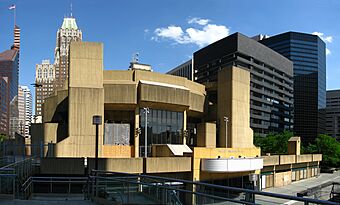Morris A. Mechanic Theatre facts for kids

Morris A. Mechanic Theatre in 2008
|
|
| Address | 1 South Charles Street Baltimore, Maryland United States |
|---|---|
| Capacity | 1,614 |
| Construction | |
| Opened | 1967 |
| Closed | 2004 |
| Demolished | 2014 |
| Years active | 1967-2004 |
The Morris A. Mechanic Theatre was a famous playhouse in Baltimore, Maryland. It was located at 1 South Charles Street. This theater was part of the Charles Center area in the city.
The theater was built and named after its owner, Morris A. Mechanic. He owned several theaters in Baltimore. Most of his other theaters, like Ford's Grand Opera House, have been torn down. The Mechanic Theatre itself was demolished in 2014.
Contents
History of the Mechanic Theatre
Morris A. Mechanic planned this new theater to replace an older one. That older theater was called Ford's Grand Opera House. He bought it in 1929 and had it torn down in 1964. A parking garage was built there instead.
A year later, in 1965, he also had the Stanton Theatre demolished. This was to make sure his new theater had no competition. Mechanic had bought the Stanton Theatre in 1958. He used it for live plays, variety shows, and movies.
Morris Mechanic hired architect John M. Johansen to design the building. Johansen created a style he called "functional expressionism." This style is also known as Brutalism. It uses raw, unfinished concrete. The theater was built where the offices of The Baltimore Sun newspaper used to be.
Morris Mechanic passed away in 1966 while the theater was still being built. His wife, Clarisse, helped open the theater on January 16, 1967. For many years, the Mechanic Theatre was Baltimore's main place for touring Broadway shows. It helped the city become known as a good place for theater.
Famous Shows at the Mechanic
Many Broadway plays had their first performances, or "tryouts," at the Mechanic. These shows would play in Baltimore before moving to Broadway in New York City. Some famous shows that started here include:
- I'm Solomon
- Jimmy Shine
- Applause
- The Wiz
- Smile
- Lend Me a Tenor
- Busker Alley
However, by the 1980s and 1990s, the theater started to feel too small. It was also considered outdated for the bigger shows of that time.
Theater Management and Closure
In 1998, a company called Jujamcyn Theaters started managing the Mechanic. Later, in 2000, another company bought Jujamcyn's production part. This company was SFX, which later became Clear Channel Entertainment.
The Mechanic Theatre stopped operating in 2004. This happened when the Hippodrome Theatre reopened after being restored. Clear Channel Entertainment decided to operate the Hippodrome instead. They chose not to continue their lease for the Mechanic Theatre.
Plans for the Building and Its Demolition
After closing, the Mechanic Theatre building was empty for a while. In 2005, two people named Melvin and Benjamin Greenwald bought it. They paid $6 million. Their plan was to turn the theater into shops. They also wanted to add a 10-story apartment building next to it.
Some people who wanted to save old buildings disagreed. They felt the theater building was important to history. They wanted it to be carefully updated instead of changed completely. In 2007, a city group decided not to give the building special historic status.
In 2009, a new plan was shared by David S. Brown Enterprises. They wanted to add a huge 30-story tower. This tower would have a hotel and apartments. The old theater space would become shops. The plan aimed to keep some of the building's original look.
However, in 2012, this plan was dropped. The developer then asked to tear down the building. After some delays due to historical concerns, permission was given in March 2014. The theater's underground parking garage was used until September 2014. After that, fences went up, and demolition began. The plan was to build new homes and shops there. As of 2021, no new construction had started.
Building Design and Appearance
The Mechanic Theatre had a unique design. It sat on a square base that held shops and an underground parking garage. The main part of the theater, where the audience sat, was shaped like a fan. It could seat 1,614 people.
You could enter the theater from the street or from a walkway. This walkway connected to other buildings in Charles Center. The balconies inside the theater stuck out past the outside walls. This made the building look a bit like a gear when seen from above.
The outside of the building was made of rough concrete. You could even see the marks from the wooden forms used to shape the walls. The main entrance led to stairs that took people to the lobby. The lobby had glass walls facing the outside. Inside, the walls had a wood-like finish or were covered in orange material.
In November 2009, a travel website called Virtual Tourist.com made a list. They named the Mechanic Theatre as the number one "ugliest building" on their list.

